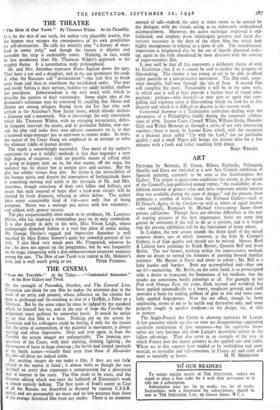ART
Picruits by Bermejo, El Greco, Ribera, Zurbaran, Velasquez, Murillo and Goya are included in a new Arts Council exhibition of Spanish painting, currently to be seen at the Southampton Art Gallery. The return to peace-time conditions has meant, in the words of the Council's just-published annual report, "the availability of ex- hibition material of greater value and more important artistic interest than was available during the years of danger," and the present show embraces a number of works from the National Gallery—such as El Greco's Agony in the Garden—as well as others of equal interest —for example, Bermejo's St. Michael Overcoming Satan—from private collections. Though there are obvious difficulties in the way of touring pictures of the first importance, there are none that cannot be overcome if the will to do so is present, and it is hoped that the present exhibition will be the forerunner of many others. In London, the new season sounds the death knell of the mixed summer shows, one of which. however, at the little St. George's Gallery, is of high quality and should not be missed. Messrs. Reid & Lefevre have paintings by Keith Baynes, Quentin Bell and Sven Berlin. The two former, working within the impressionist method, show no desire to extend the frontiers of painting beyond familiar territory. Mr. Baynes is fluent and sweet in colour ; Mr. Bell is a little harder and harsher. Both are accomplished and—dare one say it?—unexciting. Mr. Berlin, on the other hand, is so preoccupied with a desire to transcend the limitations of his medium, that the results are sometimes hardly paintings at all. For gxample in his Fish with Orange Eyes, the paint, thick, incised and wrinkled, has been applied spasmodically to a heavy, roughcast ground, and itself provides a basis for trailing gobbets of glue or size and some care- fully applied fingerprints. Now the net effect, though far from unpleasing, seems to me to be tactile and decorative only, and more properly sought in another medium—in the design, say, of tiles or pottery.
The Anglo-French Art Centre is showing tapestries by Lurcat. A few gouaches which are also on view are disappointing—appearing carelessly reminiscent of past successes—but the tapestries them- selves are very luscious and show Lurcat's decorative talents to the fullest advantage. They also serve as an example of the way in which France uses her minor painters in the applied arts and crafts. Where we in this country have tended to be unthinking and com- mercial, or revivalist and self-conscious, in France art and craft still


























 Previous page
Previous page